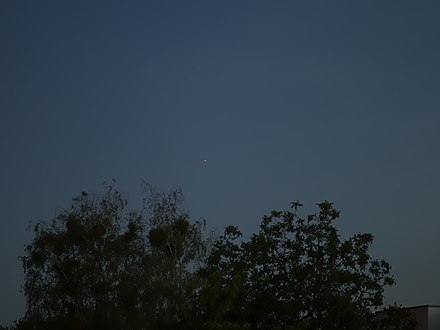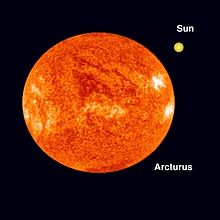Arcturus
![]()
This article describes the star in the constellation Bear Keeper, the server product of the same name is discussed under Arcturus School Server.
Database links to Arktur (Alpha Bootis)
Arcturus or Arcturus (Ancient Greek Ἀρκτοῦρος Arktúros, α Bootis, English sometimes α Boötis) is the main star in the Bear's Keeper (Bootes), a conspicuous constellation in the spring sky. Arcturus is the brightest star in the northern sky and the third brightest in the entire night sky. Only Sirius and Canopus, which is not visible from central Europe, shine brighter, but they belong to the southern sky. Arcturus is visible from all continents (except the inner Antarctic) and was probably the first star observed with a telescope in the daytime sky (1635 by Jean-Baptiste Morin). It is easily found in the extension of the drawbar of the Big Dipper. If you extend the curved train of stars beyond Arcturus in the same direction even further, you arrive at Spica.
According to measurements by the Hipparcos astrometry satellite, Arcturus is 36.7 light-years (11.3 parsecs) from Earth, so it is relatively close in astronomical terms. Arcturus, like the Sun, is currently in the Local Flake. Hipparcos' observations also suggest that Arcturus may be a binary star. However, all previous attempts to detect a companion have failed or produced a negative result. The resolution of a possible companion is currently at the limit of what is technically possible; no conclusive statement about its existence is currently possible.
Arcturus, together with the other alpha stars Spica (Virgo) and Regulus (Leo), forms the Spring Triangle; replacing Regulus by Denebola, the tail tip of Leo, it becomes an approximately equilateral one. It forms a smaller, nearly equilateral triangle with two fainter stars in the vicinity of its line of sight: Seginus (γ Bootis) and Gemma (α CrB), see star chart at right.
Physical parameters
Because of its age Arcturus is poor in metals. Its metallicity is one fifth of the Sun's, making Arcturus probably a Population II star.
Arcturus is slightly brighter than one would expect from a stable, hydrogen-fusing star. It has already begun fusing helium into carbon and oxygen. Such stars are not expected to have magnetic activity like the Sun, but very faint X-rays and a hard-to-observe "hidden" corona suggest that Arcturus is indeed magnetically active.
Luminosity and spectrum
Arcturus is a K1.5 IIIpe red giant with orange-red color. The letters "pe" stand for peculiar emission, which means that the emitted light spectrum contains comparatively many emission lines. This is not unusual for red giants, but it is particularly pronounced in Arcturus.
Arcturus is at least 110 times brighter than the Sun. Since the star emits much more radiation in the infrared spectrum than in the visible spectrum, the total radiation is about 210 times that of the Sun. The lower radiant power in the visible range compared to the Sun is due to the cooler surface.
With the satellite Hipparcos Arktur's slight brightness variations were detected. The differences are very small with 0.04 mag and a period of 8.3 days. It is assumed that the surface of the star oscillates slightly, which is a common characteristic of red giants. In the case of Arcturus, however, this was an interesting discovery. It was known that the redder a giant star is, the more variable it is. In extreme cases like Mira, strong oscillations occur over hundreds of days. Arcturus is not very red, so with its short period and small range of fluctuations, it is on the borderline between variability and stability.
Mass and size
It is difficult to determine Arktur's mass accurately, but it is likely to be comparable to the Sun's mass, being at most 1.5 times that. The star is close and large enough to easily measure its apparent diameter of 0.0210″. This gives it a diameter about 25 times that of the Sun, and the radius is just under one-eighth the distance Earth-Sun.
All Earth-like planets that would have orbited Arcturus in its young, stable phase would now have been swallowed up by it. Currently, a planet would have to be about 11 AU away from it to allow Earth-like temperatures. This would be slightly more than Saturn's distance from the Sun.
Move
The high proper motion of Arcturus is remarkable. It is higher than that of all other first-magnitude stars in the stellar neighborhood (except Alpha Centauri) and was first detected in 1718 by Edmond Halley (1656-1742). Arcturus moves at a speed of about 122 km/s relative to the solar system. Together it appears to be moving in a group of 52 other stars, also called the "Arcturian Group".
Arcturus is now almost at its closest point to the Sun, which it will reach in about 4000 years. During this time it will only decrease its distance by about 0.1%. It has only been visible to the unaided eye for about half a million years and will become invisible to the unaided eye again in about the same time as it continues its journey in its own orbit around the Milky Way.

Arcturus is the brightest star in the constellation Bootes.

Arcturus (center of image) at the end of June shortly before setting and just before civil twilight in the northwest of Berlin

Comparison between the size of Arctur and the sun.

Arcturus compared to other celestial bodies (image 4, second from right, between Pollux and Aldebaran)
Age and origin
Arcturus is considered a relatively old star in the disk plane of the Milky Way. Its age (since the beginning of hydrogen burning) is estimated to be between 5 and 8 billion years. It is thus about twice as old as the solar system and the oldest object visible to the naked eye.
According to recent findings, Arcturus did not form in the Milky Way, but probably in a dwarf galaxy that the Milky Way incorporated about 5 to 8 billion years ago, similar to the Sagittarius dwarf galaxy and the Large Magellanic Cloud at present.
Questions and Answers
Q: What is Arcturus?
A: Arcturus is the brightest star in the northern celestial hemisphere.
Q: Where is Arcturus located?
A: Arcturus is located in the constellation Boötes.
Q: What is the apparent magnitude of Arcturus?
A: The apparent magnitude of Arcturus is −0.04.
Q: How does Arcturus compare to other stars in terms of brightness?
A: Arcturus is the fourth brightest star in the night sky, after Sirius, Canopus, and Alpha Centauri.
Q: How far is Arcturus from Earth?
A: Arcturus is only 36.7 light-years from Earth.
Q: What type of star is Arcturus?
A: Arcturus is a type K1.5IIIpe orange giant star.
Q: What is the diameter of Arcturus?
A: The diameter of Arcturus is around 40 million kilometers.
Search within the encyclopedia